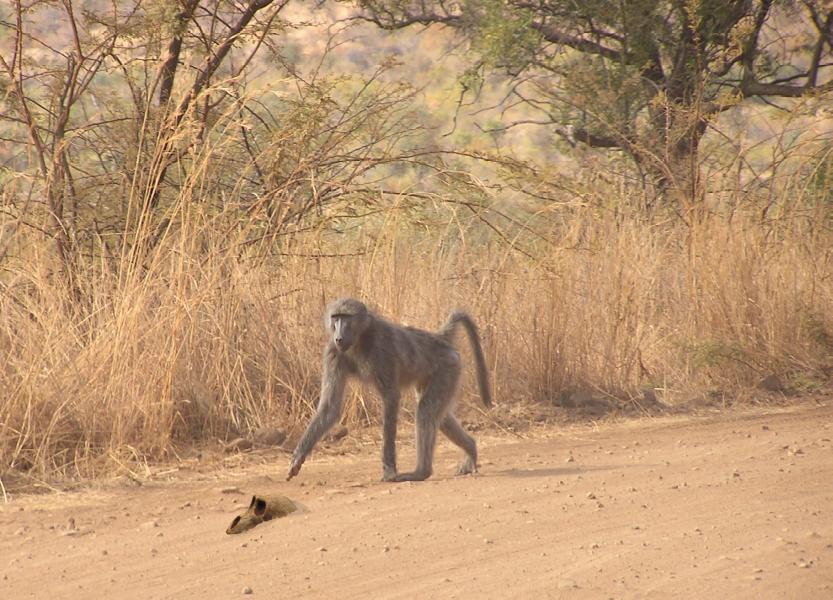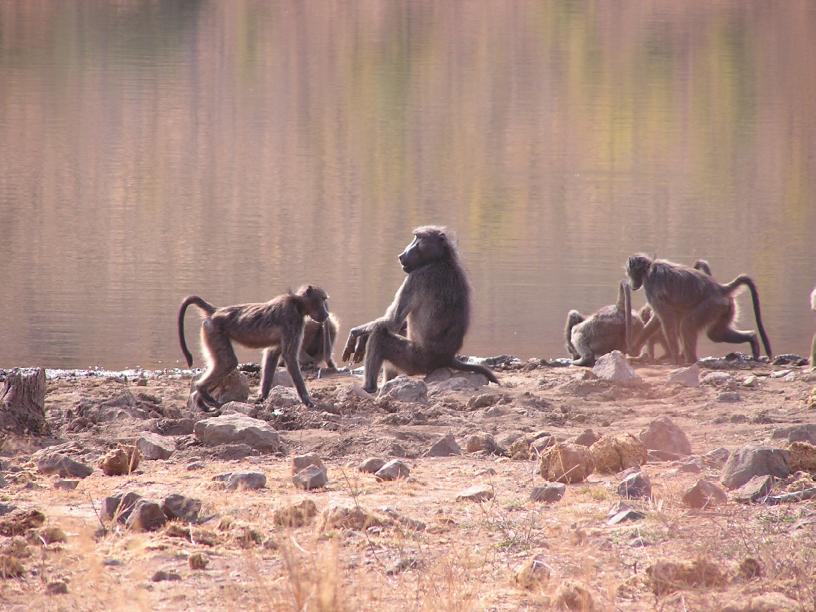Dances with Baboons
Our fossil excavations yielded a large number of extinct baboon fossils, but the living baboons that frequent the site are fascinating as well. I’ve always enjoyed the two troops of baboons that frequented our site. One troop came regularly from the northwest, the other came on occasion from the south to challenge the local troop. Baboons are very clever primates. As our third cousins, these monkeys are not given as much credit for intelligence as they should. When I was in Buxton alone, without my students, I often spent some time watching the local troop, and how it changed throughout the years. By wearing the same denim jacket and green cap, they got used to me as I habituated the troop to my presence. I got close enough to make enough observations for a few short scientific papers, but my best times with the baboons were just for fun rather than science.
One time I got close enough to sit amongst the troop as they fed on the roots and tubers near the Thamasikwa river. I must have been there 15 minutes or so before the dominant male became agitated. He was a vociferous one we called “Tripod,” who had lost a leg to one of the snares that the locals put out for the baboons to keep them from raiding their meager gardens. It didn’t keep him down, and perhaps his recovery gave him more authority. As I sat peacefully, pretending to ear roots, Tripod suddenly started barking loudly, in a sound I’ve mastered for getting my students’ attention in class. Primatologists call the bark a “waa hoo,” but that term hardly does justice to the loud, guttural, and fear-inducing sound that was reverberating throughout the valley. I thought I was in big trouble.
Tripod then started chasing the younger males up and down the river’s edge in a display of dominance. I inched closer to the river, just in case I needed to swim for safety. But fortunately the display apparently wasn’t for me. I didn’t think it was, anyway, at the time, but in retrospect I still wonder.
Nevertheless, a few days later, as the troop settled on the Ghaap escarpment for the night, I got my revenge. It was an episode I’ve since called ‘dances with baboons.’ There was nobody around at sunset, save me and the baboons. I don’t know what got into me. Maybe boredom, maybe loneliness, maybe chutzpa, likely one beer too many, but I decided to try to take over the troop from Tripod. It was near the end of the field season, so my habituation of the troop was no longer necessary.
I stood on the quarry floor below the escarpment. I had my walking stick, aka a ‘knobkerry’ in local language, which is a solid club, just in case things went awry. I let out my best waa hoo. The females of the troop panted “wa ha wa ha wah.” Tripod challenged me with his more professional waa hoo. “Wa ha wa ha wa ha” went the troop, now with the juveniles joining in, and scampering around to see what was happening.
I kept it up, knobkerry in hand. I was a good distance away, thank goodness, but close enough to see that Tripod was rolling his eyelids back, a sure sign of aggression. I couldn’t do that, as humans are not endowed with that skill. But I could do the threatening crouch moves he was doing. And so I assumed a more baboon-like stance, and repeated quick crouches, eliciting more and varied vocalizations from the troop.
Conveniently, the sun started to set, and as it had never been my goal to take over a baboon troop when I first set out for Taung, I backed away. Slowly at first, and once I got out of sight, a bit more quickly. Tripod could keep his troop, and I could keep my life. But given the intelligence of baboons, I’d bet that our evening together lived in their memories for some time. I’m certain that it lasted in mine longer.
The events of that evening, with no other human being on site or in sight. Somebody must have caught a glimpse of what was going on, and passed it on through the ‘bush telegraph’ – one person tells another, and it quickly spreads throughout the village. It is quicker than the internet. The next morning I was dubbed, by more than one worker, as “Mr. Jeff, baboon friend.” In Tswana culture, that is not a compliment.


Copyright Jeffrey K McKee 2025